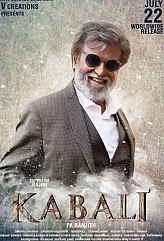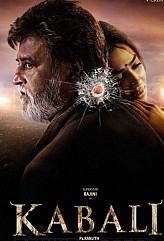Kabali is a great film!
Home > Visitor Columns

Behindwoods.com isn't responsible for the views expressed by the visitor in this column. The visitor claims that this column is his/her own. If the column infringes any copyrights that you hold, please email us at columns@behindwoods.com.
Kabali's merits and demerits. There are no demerits. Magizhchi
It’s a great film.
Negative reactions for a great film can (i) ruin its longevity at cinema screens, (ii) reduce box office collections, (iii) increase predatory tendencies in distributor pricing mechanics, (iv) incur the wrath of die-hard fans who fall victim to said tactics and hence display undesirable blasphemous response such as the tearing of Rajinikanth cut-outs, as opposed to the more desirable reverent response of bathing Rajinikanth cut-outs in milk and hence contributing to increased incidences of skin cancer in Australia (see end note), all of which result in negative publicity which can GOTO line 1. So, until the Australian government starts taking better care of their coral reefs, you better like Kabali as well (read the rest of the end note).
The director Pa. Ranjith has clearly taken extreme civil liberties in the temporal placement of the story, and it’s not clear where in the Malaysian ethnopolitical time scape this one fits. Tamil political representation and equality, which the protagonists are fighting for began to be implemented in the 1970s according to Wikipedia (a most trustworthy source for objective scientific literature for the more rigorous analyst and invariably accurate to within machine precision on such topics as Biot-Savart Law of magnetism and the color of Che Guevara's green Beret), but the flashback with the political agitation is set in the late 80s to early 90s. If one is using the commonly accepted log-normal Mani Rathnam scale first established in the superhit movie Nayagan and thence reused in literally every gritty gangster flick since, viz.:
Police Jeep = 1940s
Boat = 1950s
Boat with Silk Smitha = 1960s
4 Ambulances = 1970s
Exploding Ambassador = 1980s
This movie is an indeterminate outlier because the Mercedes Benz 380 which features prominently in Kabali does not feature on this scale. So what? To overcome this difficulty, we simply renormalize the scale without-loss-of-generality to the Ranjith scale as
Mercedes Benz 380 = 1940s
Mercedes Benz 380 = 1950s
Mercedes Benz 380 = 1960s
Mercedes Benz 380 = 1970s
Mercedes Benz 380 = 1980s
Mercedes Benz 380 = 1990s
Mercedes Benz 380 = 2000s
Mercedes Benz 380 = 2010s
And this problem goes away. The point is that when telling a story about racial tensions, impact matters. Historical accuracy is for biased BBC documentaries.
This movie is the kind of gangster flick Tamil cinema has been waiting for after Nayagan. It has all the ingredients in perfect proportions. Story - yes, action - yes, drama - yes, sentiment - yes, music - yes, style - oh yes! That Rajinikanth can act like this was a pleasant revelation. That he can still pull of the swagger was ultimate elevation. Punch eh? An affirmative nod to a fictitious person sitting beside me.
Some of the reviews I saw or read mentioned that this was a letdown for fans. That there was none of the usual Rajiniisms. That there was no comedy. That there were no song and dance sequences. Fiddlesticks. I ask the average critic who hides behind "fans felt let down because...", have you ever gone through a life-threatening illness and come back to 100% physical fitness within 4 years? Rajinikanth is 65, and he has returned from a debilitating illness. So, you claim to represent his fans, and yet you expect our Thalaivar to strut about with a teenager's speed and energy level for 2 and half hours. No, wait - you only have to sit in a chair for that long - he probably had to shoot behind the camera with makeup, wig and three-piece suit in stifling tropical heat for almost a year! Given his age and health, isn't it reward enough for him to occupy the screen for almost the entire duration and do whatever little he does with grace? To those critics, I only have to say, as someone who stood in line, bought the ticket and watched the movie, you are free to rant your heart out. But you are not free to hijack the voice of fans as your own. You are also not free to hide behind "fans felt that..." to peddle your own opinions.
The movie is just the right length. A Rajinikanth movie is a festival. It is happening these days with an all too disturbing irregularity. So, when it does happen, nothing is "too long," especially if we get to see Thalaivar on screen almost all the time. If you can enjoy the narrative structure of Nayagan, Thalapathy, Memento or Django Unchained, you will do fine with this one.
As I said before, if the message is strong, like highlighting the plight of a racially discriminated Diaspora, wouldn't you rather have the voice that carries farthest mouth it? The Tamil Diaspora from Tamil Nadu, is either an ultra-successful computing powerhouse in Palo Alto, or long-suffering lower caste casual labor class in Middle East and Southeast Asia. Abandoned by a political machine that outwardly espouses Ambedkarism and in effect kills meritocracy, the former group was forced to migrate westward towards a true appreciation of their skill set. Abandoned by a political machine that outwardly espouses Ambedkarism and actually eschews that lower castes through a repressive affirmative action scheme that elevated only the landed upper caste gentry, the latter group was forced to migrate radically outward to greener pastures. When Rajini says that the politics behind Gandhi's loincloth and Ambedkar's suit (and his), are very different, there is a poignant undercurrent there. Gandhi was fighting for the representation of a people. Ambedkar was fighting for their upliftment. So, Pa. Ranjith's message is important. So, the vehicle of Rajinikanth, someone who has broken the same class barrier, and no one else, needed to be the vehicle for this message.
Every conflict needs a context to be well motivated. So taking time to explain the conflict between Rajini's gang and another gang is necessary. For the typical non-violent viewer to empathize with a group that is taking up arms against another, it is critical to see the consequences of gang-culture starkly. It is important to understand why violence has to be fought with violence in this case, and why violence, even for the triumph of good, is ultimately self-defeating. That is a profound philosophy, but a better reference than this blog post would be the Mahabharata. And to those citing the quest for his wife as too long, it builds up tension to a tremendous payoff. One, a man is going to see the love of his life after 25 years. My mom cries every time I get to the security check at the airport. Two, you are going to witness an electrifying moment from two great actors. A true movie lover can wait for a good payoff.
Finally, there's the standard critic's spiel that the villains are not strong enough. Intriguingly, like a breaking news story that's suspiciously similarly worded between different media outlets, different critics seem to share this sentiment. I have seen multiple reviews stating that the Chinese guy butchers Tamil and that he is more comical than villainous. Huh. A popular sentiment from folk who I would like to see pronounce Ah Nong Haseyo correctly first time out. I was in Busan recently, and it’s Korean for hello. See what I'm getting at? A Chinese guy need not perform exposition in Tamil. It’s far better than a ridiculous Tamil voice-over that some directors have taken to these days. And, he is a white collar villain, and white collar villains are not always twirling their moustaches and laughing manically.
There's nothing much for me to say about the acting, casting, music, cinematography and visual effects that other reviews which you've probably lapped up by now haven't said. It’s a great film.
End note: Bathing Rajinikanth cut-outs, or any other cut-outs for that matter is an utter waste of precious life-giving milk. These days, milk is obtained largely by mechanized pumps from cows kept in deplorable factory-farm conditions. Under these circumstances, the poor cows develop severe gastro-intestinal problems and increase their flatulence many-fold. Cow flatulence produces excessive quantities of methane, a greenhouse gas which is known to be an important contributor to the ozone layer depletion occurring most rapidly over Australia. The absence of an ozone screen in our atmosphere causes harmful ultraviolet rays from the sun to be directly absorbed by the human skin. Australians hence have increased incidences of skin cancer. However, the new Australian regime seems to be oblivious to the detrimental effects to our planet and to society at large, in their ultra-conservative push towards severely restricted environmental conservationism. And there is more corruption in the Indian government than stopping one cut-out 'paal abishekam' can emancipate the malnourished. So, everyone's better off liking Kabali.
vamsiks2003@gmail.com
Please send your column to columns@behindwoods.com.

FACEBOOK COMMENTS
OTHER LATEST VISITOR COLUMNS
RELATED NEWS
- Amitabh Bachchan to remake Kabali in Hindi?
- ‘‘Rajinikanth still holds the audience enthralled’’ says this veteran actress!
- Vairamuthu clarifies on his controversial comment about Kabali
- Superstar thanks the audience for Kabali success
- Record breaking collection in Chennai for Kabali
- Dhanush talks about Kabali


